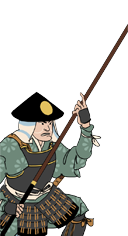
Basic Unit Statistics (can be modified by difficulty level, arts, skills, traits and retainers)
| Recruitment Cost | 520 | |
| Upkeep Cost | 100 | |
| Melee Attack | 7 | 20% |
| Charge Bonus | 1 | 2% |
| Bonus vs Cavalry | 30 | 100% |
| Melee Defence | 5 | 14% |
| Armour | 3 | 20% |
| Morale | 6 | 12% |
Strengths & Weaknesses
- Extended spear makes them excellent against cavalry.
- Good defensive unit.
- Vulnerable to missiles and sword infantry.
- Higher than average ashigaru morale.
Abilities
- Yari Wall - A tight-packed formation presenting a wall of yari to the front to deter enemy cavalry attack
Description
These men carry exceptionally long spears, pikes in effect, making them extremely dangerous to cavalry.
These ashigaru are an exceptionally useful anti-cavalry force, and strong defensively as long as their morale holds up. However, their long spears can count against them at times. Against sword-armed infantry in close combat, the length of the spears is next to useless. They are also vulnerable to missile attacks, like many other specialist troops. Men, no matter how trained or equipped, all die in the same way when perforated by arrows or bullets. All clans experimented with weapons and tactics: spear length varied enormously, with some Oda units essentially carrying pikes, spears up to 5m long. It is fascinating to speculate what might have happened to Japanese warfare if the Sengoku Jidai had not ended when it did. Would the samurai have evolved a style of battle that paralleled the "pike and shot" tactics of 17th Century Europe? European pikemen, in theory, protected the musketeers who shot at the enemy but had ridiculously long reloading times. Often, and partly as a result of the desultory rates of gunfire, European battles became giant shoving matches as the pikemen moved forwards to physically push their enemies off the field. Men were so crammed together that it was difficult for them to fight as individuals in any way. Would the Japanese have gone the same way, or would samurai honour and individualistic glory have triumphed?